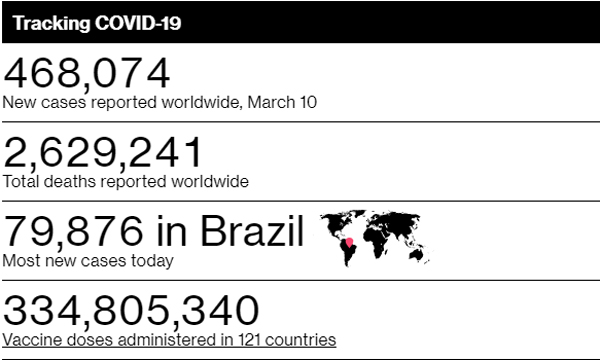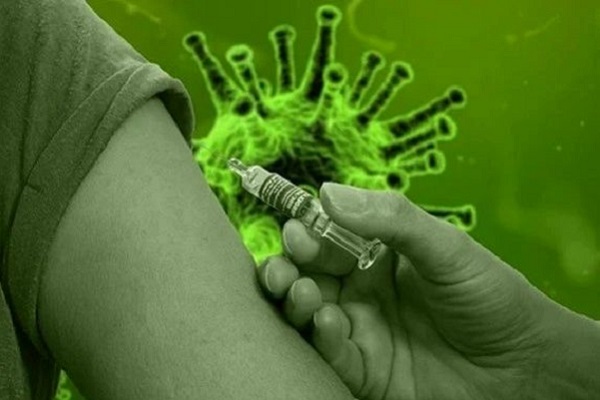The speed at which the world, and international tourism, will return to normal will be measured in vaccinations, as calculated by US-based financial media company Bloomberg.
Writing for Destination Thailand News, experience aviation executive Joe Cusmano analyses the findings of Bloomberg’s vaccination calculator, which shows how long it will take and countries to vaccinate 75% of their populations
Bloomberg has built the biggest database of COVID-19 shots given around the world, with more than 119 million doses administered worldwide. US science officials such as Dr Anthony Fauci (Director of the U.S. National Institute of Allergy and Infectious Diseases and the Chief Medical Advisor to the US President) have suggested it will take 70% to 85% coverage of the population for things to return to normal.
Bloomberg’s Vaccine Tracker shows that some countries are making far more rapid progress than others, using 75% coverage with a two-dose vaccine as a target.
Israel, the country with the highest vaccination rate in the world, is headed for 75% coverage in just two months. The USA will get there just in time to ring in the New Year. With vaccinations happening more rapidly in richer Western countries than the rest of the globe, it will take the world as a whole seven years at the current pace.
Bloomberg’s calculator provides a snapshot in time, designed to put today’s vaccination rates into perspective. It uses the most recent rolling average of vaccinations, which means that as vaccination numbers pick up, the time needed to hit the 75% threshold will fall.
The calculations will be volatile, especially in the early days of the rollout, and the numbers can be distorted by temporary disruptions.
For example, New York’s target date was briefly pushed out to 17 months this week after a winter blizzard prevented some from getting vaccinated (it’s now back down to 13 months). Likewise, Canada’s vaccination rate dropped by half in recent weeks following reports of delayed vaccine shipments. Based on Canada’s latest rate of inoculations it would take more than 10 years to reach 75% coverage. That might serve as a wake-up call to Canadian politicians and health officials, but it does not mean the country is doomed to a decade of social distancing. Canada has contracts to buy more vaccine doses per person than any other country, and its vaccination rates are expected to climb.

The pace is likely to accelerate further as more vaccines become available. Some of the world’s biggest vaccine-manufacturing hubs in India and Mexico are only just getting started. More than 8.5 billion doses of vaccine have been contracted by countries through more than 100 agreements tracked by Bloomberg. Only a third of countries have even begun their vaccination campaigns.
Vaccinations protect against COVID-19 within a few weeks of getting the shots. But if just a few people in a community get vaccinated, the virus can continue to spread unchecked. As more people get the vaccine, groups of people start to build a collective defence against the virus so that isolated sparks of infection burn out instead of spreading into an outbreak. The concept is known as herd immunity.
In the scientific community, there are conflicting definitions for when herd immunity is achieved. Is it when enough people are protected that it begins to have a measurable effect on the speed of transmission? That could begin well before 75% of people are fully vaccinated. Others define it as the point when outbreaks can no longer be sustained. For example, even if there’s a cluster of measles cases in an unvaccinated community, herd immunity prevents it from rippling across a country.
The vaccines available today require two doses for full vaccination. The calculations for coverage are based on two doses per person in the population but don’t distinguish between first doses or second doses administered. Those breakdowns can distort daily vaccination rates and are not available in more than 20% of the countries tracked by Bloomberg.
A new vaccine by Johnson & Johnson recently showed positive results using a single dose in a large clinical trial. If approved, the numbers will be adjusted according to the number of doses required proportionate to its market share in each country.
The vaccines have not been authorized for use in children those studies are currently underway. The calculator, like the virus, includes children in the population needed to be protected.
One metric Bloomberg’s calculator does not account for is any level of natural immunity that might result from recovering from COVID-19. It is possible that hard-hit places might require a lower level of vaccination to prevent widespread transmission. While there’s evidence that people who recover from illness do retain some level of natural defences, it’s unclear how much protection is offered or how long it might last. The vaccine is still recommended for people who have recovered from illness.
The calculator is the latest feature from Bloomberg’s Covid-19 Tracker. The projections are updated daily and are based on the average daily vaccinations in data gathered from 67 countries and the USA’s states and territories. Countries may be excluded when they are in the earliest stages of vaccinations or if they provide infrequent updates on their vaccination numbers.
Contributed and edited by Joe Cusmano of Stray Nomad.
Lower image credit Bloomberg.
About the author
An experinced airline and travel industry professional, Joe has over 25 years international airline sales experience of which 18 have been in senior positions in Australia, North Africa and Europe, Middle East and Thailand.
Committed to sharing news and personal experiences, he explains that, post-COVID, "once I resume travelling with people that like me are nomads by nature and love to travel, (I will) provide you with as much advice and tips to make your travel experience a memorable one."
Click here to visit his website.
Read more from this author
Related Articles
11th March 2021 - Report suggest Tokyo Olympics and Paralympics will not feature overseas spectators
8th March 2021 - Research suggests face masks are safe to wear during intense exercise
3rd March 2021 - Thailand’s Tourism Sector petitions to reopen the country by 1st July 2021
3rd March 2021 - World Rugby recommends 2021 Women’s World Cup be delayed for a year
18th February 2021 - Hong Kong Disneyland park to reopen with enhanced hygiene measures
17th February 2021 - Japan’s fitness industry faces up to post-Coronavirus lockdown challenge
15th February 2021 - Coronavirus restrictions force postponement of FIBA Asia Cup qualifiers in Qatar
14th February 2021 - ASM Global’s Harvey Lister looks to ‘full revival’ of live events in 2022
7th February 2021 - Anantara Resorts reopens luxury destinations on Abu Dhabi’s Yas Island
6th February 2021 - WTTC says governments should abandon notion of ‘high-risk countries’ and instead focus on ‘high-risk travellers’
4th February 2021 - Sri Lanka reopens to international tourists with 14-day bio-bubble arrangement
28th January 2021 - Frozen the Musical at Sydney’s Capitol Theatre a model for future global performances
27th January 2021 - Researchers suggest global event industry can benefit from COVID rapid lateral flow tests
13th January 2021 - Chinese F1 Grand Prix postponed to second half of 2021
12th January 2021 - Thailand’s tourism sector continues to reopen safely and slowly
10th December 2020 - Australians look forward to introduction of COVID-19 vaccine
2nd December 2020 - Tourism Authority of Thailand collaborates with Locanation to inform foreign visitors on hotel quarantine standards
20th November 2020 - Thailand’s Kamalaya Sanctuary secures global award for Health and Wellness Destination of the Year
31st October 2020 - GlobalData highlights domestic tourism may not be sufficient for Thailand tourism recovery
1st September 2020 - Thailand faces tourism industry risk








